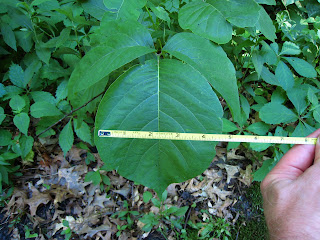Urushiol is the name of the oil that is on the surface of the leaf, that when it comes in contact with skin, can cause a severe rash, or what is sometimes called "contact dermatitis". The really insidious thing about Urushiol is that it can cling to clothing, fur, gear like back packs when you set them down, shoe leather, boot leather, walking sticks, socks, gaiters, and just about anything that has a dry surface and can absorb the oil.
 | |
| Bush-type Poison Ivy Five Feet Tall |
One possible bushcraft solution if you develop the rash on your skin, though I have never had the occasion to test this remedy, comes to me from my father as he tells it. He learned of this from local native americans while living on Minnesota's Iron Range near some tribal settlements. Their remedy was to boil the bark of the tamarack tree over an open fire, until the water in the large container (read laundry tub perhaps?) was very dark, indicating all the tannins had been leached out. These tannins have an astringent affect and when exposed skin is saturated with this tamarack\tannin mixture (usually by immersion) it acts to treat the poison ivy and the itch. It also stains the skin a dark brown, which as my father says, "Takes a long time to wear off." When I asked him how he knows this, he said that his big brother tried this method for his poison ivy and it worked, but that his brother was "sun tanned" for the entire summer. I would like to have seen pictures. My dad also wants me to mention that you should never burn wood that has any dead poison ivy vines or leaves on it, nor should you ever burn poison ivy in any way, as the urushiol oil is carried in the smoke and can get into your lungs, nasal passages and onto you lips and tongue.
Some people appear to be immune, but this immunity can change with time and maybe you never got it as a youth, you might as an adult. Do not attempt to find out. "Leaves of Three, Let It Be". Here in Minnesota we are fortunate enough to not have any poison oak or poison sumac, or we would be triple threatened. But poison ivy gives us enough to worry about. Teach your friends, your family and especially your children. Wearing long pants on hikes where there is any possibility of contacting poison ivy is a must.
For more information follow this link to discover more then you would ever want to know about poison ivy and how to deal with it. Poison-Ivy
As always, happy exploring and when Poison Ivy is in season, be safe.


No comments:
Post a Comment